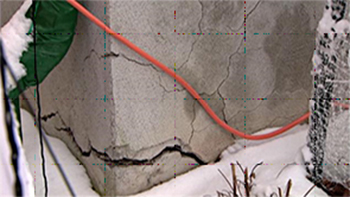Protect your investment
Pyrite Issues
"Pyrite issues" happen whenever a granular fill under a slab is made of pyrite bearing crushed shale or crushed mudstone. Under humid stress, the pyrite will free SO2 that will eventually combine with water to produce sulfuric acid, which is much detrimental to limestone based minerals such as the surrounding granular fill and which can delaminate the under-slab soaking in acidic water. Swelling and cracking of the concrete slab will ensue and foundation wall dislocation may even be observed. The thickest the granular fill, the worse the reaction will be.
Under specific conditions, moisture and oxygen will oxidize the pyrite. The chemical reaction that ensues causes swelling of the backfill and is likely to lift the concrete slab. In some cases, sulfation can also attack the underside of the concrete slab.
Problems associated with pyrite may appear as early as ten years after construction of the house; generally, damages will be consecutive to a French drain malfunction, but it can also be faster or can be much slower, not showing up until 20 or even over 25 years. As chemical reactions of pyrite are difficult to predict, the concerned owner rarely knows what to expect.
In Quebec, this phenomenon is widespread in the Eastern Township, and also in the Boucherville or Riviere-des-Prairies areas. It mainly affects the buildings constructed in the 1980s but is also found in homes built before 1970 or even after 1998.
Since April 1999, the construction industry voluntarily applies the CTQ-M100 standard which aims to certify the quality of non-swelling backfill used in construction. Owners should require the contractor doing concrete slab construction or renovation to provide their original delivery stub confirming that the crushed stones used are certified "DB".
The Association of Consultants and Experts Laboratories (ACLE) is advising owners who must undergo “pyrite testing†to choose an acknowledged laboratory, such as Solroc.
Pyrrhotite Issues
Pyrrhotite is another iron sulphide, naturally occurring in igneous rock.
Because it oxidizes in air with moisture and because it will then release sulfuric acid, which attacks the cement paste, pyrrhotite should not be used in the aggregate that is poured in concrete.
Unfortunately, crushed stone containing 1% and plus of pyrrhotite, from two deleterious quarries near Trois-Rivières, was used to produce several new house concrete slabs or foundation walls between the late 1990s and mid-2000s.
Therefore, hundreds of home owners in the Trois-Rivières area are experiencing major concrete deterioration issues related to the presence of pyrrhotite in the concrete. With time, the consecutive crazing of the concrete will decrease the bearing capacity of the foundation and the slab.
Crazing is the first characteristic of reacting pyrrhotite in the concrete. These are shown as crisscross, star-shaped or simply crazing patterns.
Solroc can diagnose and quantify this kind of problem and can provide the required evidence in court.
Ask Solroc to assess the reality or extent of pyrrhotite issues in your building.

When concrete slab swelling, fracturing or wall dislocation appear, call SOLROC
SOLROC is widely known for its outstanding expertise regarding concrete damage issues. Cracks, kinks and concrete defects are regularly investigated by SOLROC. Material quality control is another of SOLROC capabilities.




